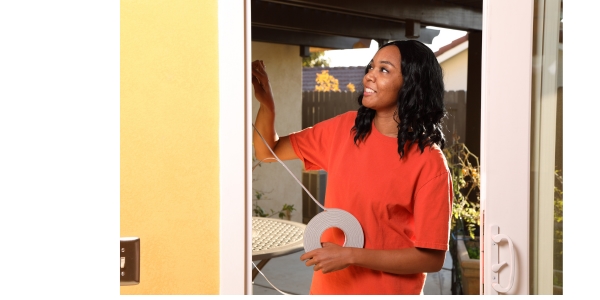As we move toward summer and temperatures start to soar, are you thinking about the rising electricity bills that come with running the AC? Here at Uprise, many of our neighbors reach out to us at this time of year to talk about adding solar to their home to reduce their energy bills. We always stress that you can add to that solar savings by using your energy wisely. When you pair a solar system with DIY energy efficiency projects, you’ll reduce your bill even further, and the combined environmental benefit of these home improvements is powerful.
The good news is there are loads of simple DIY energy efficiency projects that’ll improve your home’s comfort. So in honor of Earth Day every day, here are our top ten energy efficiency tips to get you started:
1. Service your air conditioner
It’s super important to make sure your AC system is in top shape. Easy maintenance such as routinely replacing or cleaning air filters can lower your cooling system’s energy consumption by up to 15 percent. Pull out your old one to check the size, then order new ones if your HVAC company hasn’t done it for you. Also, set an annual calendar reminder to check your air conditioner’s evaporator coil, which should be cleaned every spring to ensure the system performs optimally.
2. Use ceiling fans
A ceiling fan not only creates a breeze in your home but also moves cooled air to maximize your air conditioner’s efforts. Cooling your home with ceiling fans can allow you to raise your thermostat up to four degrees. This can help lower your electricity bills without sacrificing overall comfort. Ceiling fans these days are easy to install, and come in loads of modern styles, from glam to sleek.

3. Cook outside
In case anyone needs an extra excuse to grill, it’s a money-saving move as well as a great way to enjoy the outdoors on a nice evening. If you don’t use your stove or oven indoors, it keeps the heat out of your home and reduces the need for indoor cooling.

We love to see outdoor grills that are not hooked to a natural gas line, since such hookups just prolong our dependence on fossil fuels. Rather, standalone grills like a simple charcoal grill or maybe a fancy pellet smoker grill offer outdoor cooking options without drawing dirty fossil fuel through a pipeline to cook your burgers. Better yet, not using your indoor stove means you’ll save energy on either the electricity or gas it uses — in addition to reducing the need for extra AC needed to keep the kitchen cool. Win-win-win!
4. Install a clothesline or drying rack
Clothes dryers can account for up to six percent of a home’s total energy use. Be energy smart by hanging your clothes to air dry when possible. You can use a standalone rack, or attach an easy-to-install, retractable clothesline to any wall indoors or outdoors, easy peasy.

5. Set the thermostat and automate usage
A smart thermostat can reduce your heating and cooling costs by up to 15 percent. It works by learning your habits and adjusting the temperature automatically. For example, if you tend to turn the temperature down before bed at 10pm, a smart thermostat will start making that adjustment automatically. You can also control a smart thermostat from an app. So if your schedule changes unexpectedly, you can still maintain control of your heating and cooling costs from the palm of your hand.

6. Buy energy efficient appliances
The Inflation Reduction Act of 2022 introduced some incredible savings on the purchase of new appliances, on top of Energy Star and other incentives already in place. So to save money in the long run, now is a great time to invest in those upgraded appliances. Look for the Energy Star label when you’re shopping for home items. Over 40 product categories feature the label, including major appliances and light fixtures.

8. Fight phantom power consumption
Devices that continue to draw power when they appear to be turned off can cost up to $200 a year in wasted energy. Fight this by regularly unplugging your devices, or let a smart power strip do the work for you.
Remember that televisions, cable boxes, PVRs, and game consoles suck energy even when they’re not in use. And chargers that are plugged in draw power even when no device is attached. Once your phones, tablets or other devices are fully charged, unplug them — they’ll keep drawing energy if you don’t.

Having devices all on a single power bar makes it easy to switch them off before everyone goes to bed. The features of advanced power strips make it easier than ever to ensure devices are fully powered down.
9. Spring cleaning project: install LED lightbulbs
One of the easiest and fastest ways to cut your monthly budget is switching to LED lightbulbs. Depending on the number of bulbs you have in your home and your typical usage, you can easily save between $25 to $100 per month just by making this change.

A typical soft white, 750 lumen LED pack of 8 bulbs is inexpensive, and each bulb should last about seven years. It’s a true no-brainer if you haven’t changed every lightbulb in the house yet, because you’ll save money immediately. You can even buy Wi-Fi enabled lightbulbs that can be programmed or controlled through Alexa or on your phone.
9. Caulk and seal air leaks in your home
These simple DIY energy efficiency projects can save you big. It’s amazing to learn how much of your cooled (or in winter, heated) air escapes through small gaps in windows, doors, even outlets and lighting. Here are some easy DIY ways to close those gaps:

- Install energy efficient window treatments: Energy efficient window treatments or coverings such as blinds, shades, and films can slash heat gain when temperatures rise. If you install simple thermal curtains, they will help keep rooms with windows warmer in winter and cooler in summer. Look for curtains described as “thermal” or “insulating.”
- Insulate electrical outlets and switches: Electrical outlets and switches may be small. But they allow lots of cool air to pass out of the home and warm air to enter. When you add up all of the outlets and switches in a house, that’s a lot of uninsulated space! Luckily there’s a simple fix: install foam gaskets behind outlet and switch covers to help block heat loss.
- Seal doors and windows: Damaged window and door seals are among the leading causes of cooling and heating loss. A smoke leak detector shows exactly where the loss is coming from. A simple DIY solution for reducing window and door energy loss is new weatherstripping and door sweeps. Both should seal any gaps in window openings and under your door.
- Seal up recessed lighting: Lighting openings are an often overlooked source of energy loss. Most thermal detectors can show if you are losing heat through these openings. If so, there are ways to insulate them safely. Be sure you have a three inch space between the lighting and the insulation for fire safety. If this isn’t possible, you may have to use airtight IC*-rated lighting.
10. Seal pipes, ducts, and attic spaces
Depending on your ability or availability, you may want to hire someone for the following larger DIY energy efficiency projects. But they’re well worth the upfront cost for the resulting savings.
- Insulate HVAC ducts: Cracked and broken HVAC ducts cause substantial energy loss. So repairing and insulating them can help improve efficiency. Start by replacing or sealing open or poorly sealed ducts. To maintain temperatures in the longer duct areas, add insulation around the ductwork. Proper sealing and insulating can save energy in warm and cold climates. Air loss through ducts can lead to high electricity costs, accounting for nearly 30 percent of a cooling system’s energy consumption. Sealing and insulating ducts can go a long way toward lowering your electricity bills.
- Insulate the attic: Insulating your attic can increase energy efficiency more than almost any other measure, since not having enough insulation interferes with your HVAC system’s ability to adequately heat and cool your home. In fact, a home with insufficient insulation loses as much as 50 percent of its conditioned air, dramatically increasing heating and cooling costs. Attics are often unfinished, so adding insulation rolls can be simple. Another alternative is adding spray foam to open areas under the roof where there’s no other insulation. Because we have warm summers here in the DMV, more insulation as a radiant barrier also makes sense. Radiant barriers feature material that reflects heat instead of absorbing it into your home, reducing air conditioning bills.
- Insulate pipes: Insulating your hot water pipes reduces heat loss and can raise water temperature 2°F – 4°F hotter than uninsulated pipes can deliver, allowing you to lower your water temperature setting. You also won’t have to wait as long for hot water when you turn on a faucet or showerhead, which helps conserve water. You can reduce your cost by three percent to five percent for every 10°F that you turn down the water heater. After insulation, the average family can turn the heater down by four degrees without noticing a difference in temperature at the tap, for a cost reduction of about two percent.
Check your utility for energy efficiency programs and rebates
All of our local utilities have some great programs to help with DIY energy efficiency projects. Check yours to see what’s available, including:
- Pepco Rebates and Discounts
- BGE Smart Energy Savings
- Dominion Energy Smart Home Program; Energy Saving Product Rebates; Energy Audit and Assessments; and more
- NOVEC Ways to Save
Take advantage of state and federal incentives
To find all of the available state and local incentives for your area, you can check the Database of State Incentives for Renewables and Efficiency (DSIRE), maintained by the NC Energy Technology Center. DSIRE will also show you what’s available for federal incentives.
Don’t forget to check the Rewiring America calculator too. The Inflation Reduction Act included many home energy efficiency incentives, along with the 30% solar tax credit, so be sure to check out your potential savings when you’re thinking about a project!
Questions? Ideas? Reach out any time!
Let us know if you have questions or thoughts about energy efficiency. We love talking about electrifying your home and reducing power bills with you! Give us a call at (202) 750-5718 or fill out the form on our site to get in touch!
